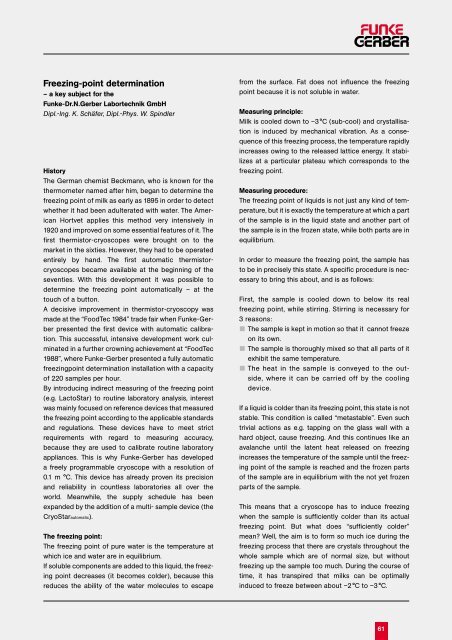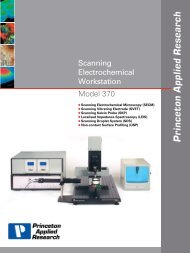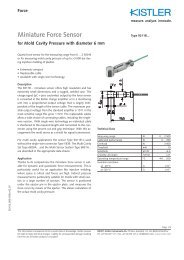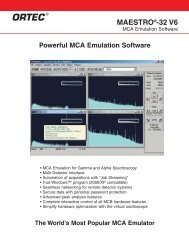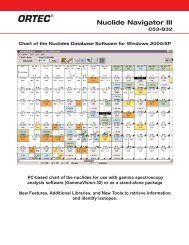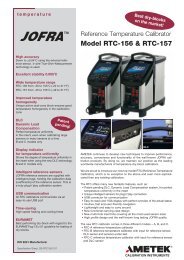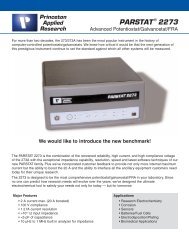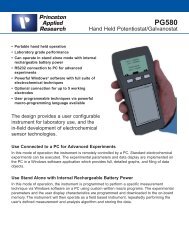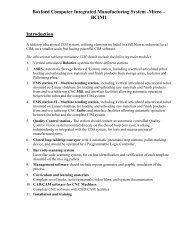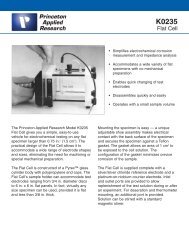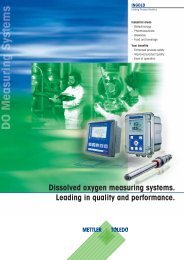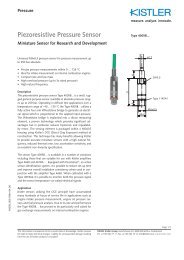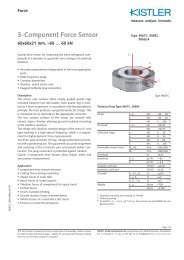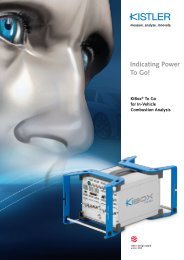Laboratory catalogue
Laboratory catalogue
Laboratory catalogue
Create successful ePaper yourself
Turn your PDF publications into a flip-book with our unique Google optimized e-Paper software.
Freezing-point determination<br />
– a key subject for the<br />
Funke-Dr.N.Gerber Labortechnik GmbH<br />
Dipl.-Ing. K. Schäfer, Dipl.-Phys. W. Spindler<br />
History<br />
The German chemist Beckmann, who is known for the<br />
thermometer named after him, began to determine the<br />
freezing point of milk as early as 1895 in order to detect<br />
whether it had been adulterated with water. The American<br />
Hortvet applies this method very intensively in<br />
1920 and improved on some essential features of it. The<br />
first thermistor-cryoscopes were brought on to the<br />
market in the sixties. However, they had to be operated<br />
entirely by hand. The first automatic thermistorcryoscopes<br />
became available at the beginning of the<br />
seventies. With this development it was possible to<br />
determine the freezing point automatically – at the<br />
touch of a button.<br />
A decisive improvement in thermistor-cryoscopy was<br />
made at the “FoodTec 1984” trade fair when Funke-Gerber<br />
presented the first device with automatic calibration.<br />
This successful, intensive development work culminated<br />
in a further crowning achievement at “FoodTec<br />
1988”, where Funke-Gerber presented a fully automatic<br />
freezingpoint determination installation with a capacity<br />
of 220 samples per hour.<br />
By introducing indirect measuring of the freezing point<br />
(e.g. LactoStar) to routine laboratory analysis, interest<br />
was mainly focused on reference devices that measured<br />
the freezing point according to the applicable standards<br />
and regulations. These devices have to meet strict<br />
requirements with regard to measuring accuracy,<br />
because they are used to calibrate routine laboratory<br />
appliances. This is why Funke-Gerber has developed<br />
a freely programmable cryoscope with a resolution of<br />
0.1 m °C. This device has already proven its precision<br />
and reliability in countless laboratories all over the<br />
world. Meanwhile, the supply schedule has been<br />
expanded by the addition of a multi- sample device (the<br />
CryoStarautomatic).<br />
The freezing point:<br />
The freezing point of pure water is the temperature at<br />
which ice and water are in equilibrium.<br />
If soluble components are added to this liquid, the freezing<br />
point decreases (it becomes colder), because this<br />
reduces the ability of the water molecules to escape<br />
from the surface. Fat does not influence the freezing<br />
point because it is not soluble in water.<br />
Measuring principle:<br />
Milk is cooled down to –3 °C (sub-cool) and crystallisation<br />
is induced by mechanical vibration. As a consequence<br />
of this freezing process, the temperature rapidly<br />
increases owing to the released lattice energy. It stabilizes<br />
at a particular plateau which corresponds to the<br />
freezing point.<br />
Measuring procedure:<br />
The freezing point of liquids is not just any kind of temperature,<br />
but it is exactly the temperature at which a part<br />
of the sample is in the liquid state and another part of<br />
the sample is in the frozen state, while both parts are in<br />
equilibrium.<br />
In order to measure the freezing point, the sample has<br />
to be in precisely this state. A specific procedure is necessary<br />
to bring this about, and is as follows:<br />
First, the sample is cooled down to below its real<br />
freezing point, while stirring. Stirring is necessary for<br />
3 reasons:<br />
The sample is kept in motion so that it cannot freeze<br />
on its own.<br />
The sample is thoroughly mixed so that all parts of it<br />
exhibit the same temperature.<br />
The heat in the sample is conveyed to the outside,<br />
where it can be carried off by the cooling<br />
device.<br />
If a liquid is colder than its freezing point, this state is not<br />
stable. This condition is called “metastable”. Even such<br />
trivial actions as e.g. tapping on the glass wall with a<br />
hard object, cause freezing. And this continues like an<br />
avalanche until the latent heat released on freezing<br />
increases the temperature of the sample until the freezing<br />
point of the sample is reached and the frozen parts<br />
of the sample are in equilibrium with the not yet frozen<br />
parts of the sample.<br />
This means that a cryoscope has to induce freezing<br />
when the sample is sufficiently colder than its actual<br />
freezing point. But what does “sufficiently colder”<br />
mean Well, the aim is to form so much ice during the<br />
freezing process that there are crystals throughout the<br />
whole sample which are of normal size, but without<br />
freezing up the sample too much. During the course of<br />
time, it has transpired that milks can be optimally<br />
induced to freeze between about –2 °C to –3 °C.<br />
61


